
Fort Necessity
Fort Necessity Museum Entrance
Wampum Belt (Reproduction).

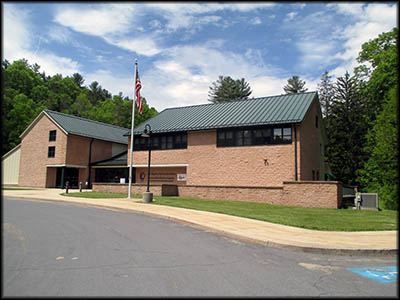

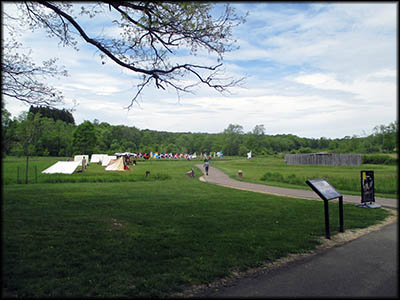
Great Meadows
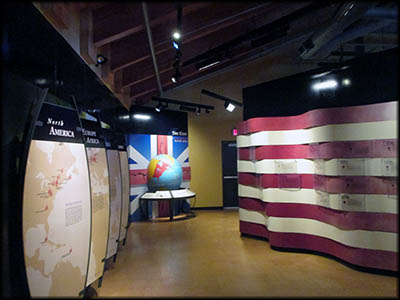
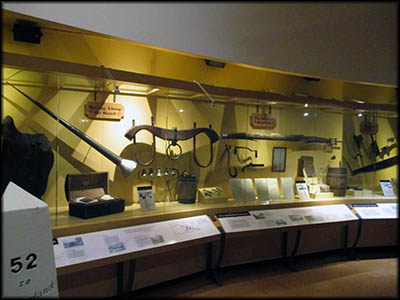
Museum Interior
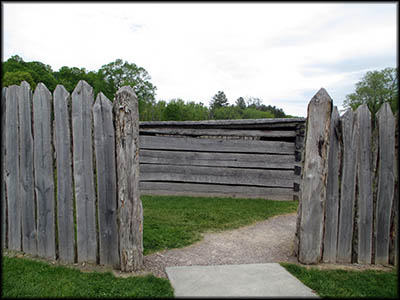
Fort Necessity Stock House (Reproduction)
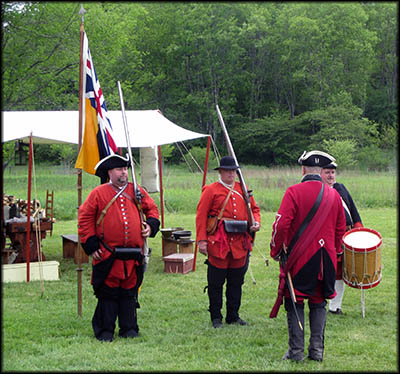
British Solider Reenactors
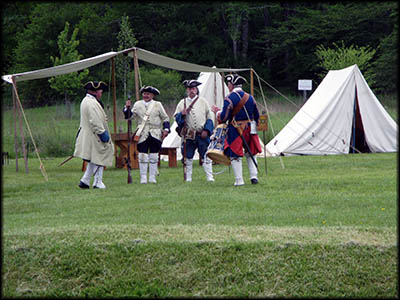
French Solider Reenactors
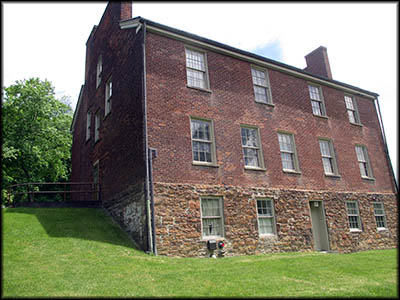
Mount Washington Tavern
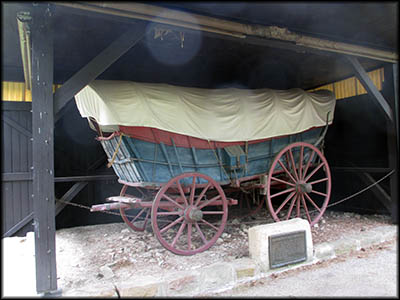
Example of a Wagon Used on the National Road
Mount Washington Tavern Interior
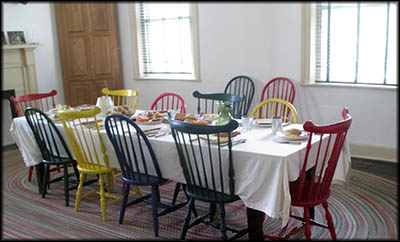
General Edward Braddock
Library of Congress
Library of Congress
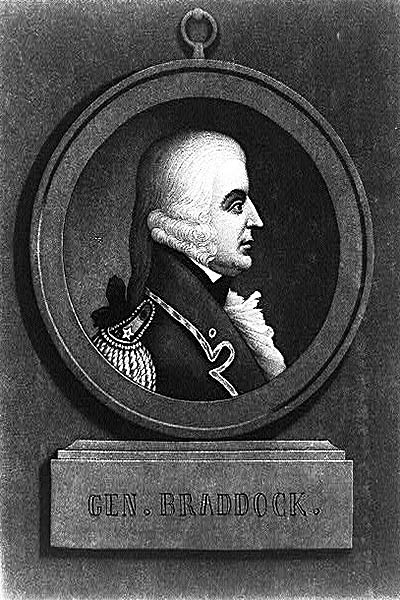
It seems whenever I visit an historic site, I miss the special events, but at Fort Necessity National Battlefield I hit the proverbial jackpot. On the day I went there were reenactors playing French and British colonial soldiers from the French and Indian War who had muskets and knew how to use them. When they did a demonstration, one of the muskets failed to go off—an excellent bit of historical accuracy because this was a common occurrence with muskets from that era. Along with, a park ranger gave an excellent explanation of what happened at the site.
The battlefield is located near Farmington, Pennsylvania. You enter the grounds through a building that includes an excellent museum. Also here is Mount Washington Tavern, which was built along the National Road as one of the many places to stop. To get to it, you have to climb a steep paved path that has a bench about half way up in case you need to rest.
Fort Necessity was built on June 4, 1754, on the orders of Lieutenant Colonel George Washington, a twenty-two year-old member of the Virginian militia whose greatest aspiration was to become an officer in the British Army—something he never achieved. Before this he’d been a surveyor, and in few short years he’d become master of a slave plantation upon inheriting Mount Vernon. At this moment he was an inexperienced officer whose poor judgement caused a world war.
Western Pennsylvania, known in the mid-eighteenth century as the Ohio County, was claimed by both the British and French. The Iroquois Confederation had its own claim to this real estate because of its value for the fur trade. The French wanted it for that same reason, and, to a lesser extent, so did the British. But for them, the land in and of itself was more valuable. Most of the property in the British Isles was in the hands a few—the gentry—so if you wanted some of your own, you had to come to the American colonies to acquire it.
Fort Necessity was built on June 4, 1754, on the orders of Lieutenant Colonel George Washington, a twenty-two year-old member of the Virginian militia whose greatest aspiration was to become an officer in the British Army—something he never achieved. Before this he’d been a surveyor, and in few short years he’d become master of a slave plantation upon inheriting Mount Vernon. At this moment he was an inexperienced officer whose poor judgement caused a world war.
Western Pennsylvania, known in the mid-eighteenth century as the Ohio County, was claimed by both the British and French. The Iroquois Confederation had its own claim to this real estate because of its value for the fur trade. The French wanted it for that same reason, and, to a lesser extent, so did the British. But for them, the land in and of itself was more valuable. Most of the property in the British Isles was in the hands a few—the gentry—so if you wanted some of your own, you had to come to the American colonies to acquire it.
Virginian’s lieutenant governor, Robert Dinwiddie, found French claims to the area so alarming, he sent a poorly trained militia led by Lieutenant Colonel George Washington to try to stop their encroachment. Washington headed to the place known as the Forks, the point where the Allegheny and Monongahela Rivers meet to form the Ohio. It’s here that Virginians who’d preceded Washington’s force were building a fort. Before he reached it, a messenger informed him that the French had chased the Virginians out and were now building what would become known as Fort Duquesne.
It was Seneca chief Tanaghrisson, a viceroy of the Iroquois Confederation, who’d suggested that the Virginians build a fort at the Forks, and he was there when the French ousted the Virginians. Although he didn’t especially like the British, he hated the French far more and hoped the English would push them off Iroquois land. He told Washington about the arrival about thirty-five French soldiers Ensign Joseph Coulon de Villiers de Jumonville who’d settled at a nearby glen, then convinced the somewhere naïve Virginian to attack them.
It was Seneca chief Tanaghrisson, a viceroy of the Iroquois Confederation, who’d suggested that the Virginians build a fort at the Forks, and he was there when the French ousted the Virginians. Although he didn’t especially like the British, he hated the French far more and hoped the English would push them off Iroquois land. He told Washington about the arrival about thirty-five French soldiers Ensign Joseph Coulon de Villiers de Jumonville who’d settled at a nearby glen, then convinced the somewhere naïve Virginian to attack them.
Washington and his Native American allies attacked at about seven in the morning on May 28, 1754. At the end of this roughly fifteen minute skirmish, de Jumonville was dead. It’s said but not verified that Tanaghrisson killed him with a tomahawk after he surrendered. The place is now known as Jumonville Glen. Washington didn’t know it at the time, but this fight had touched off French and Indian War, known in Europe as the Seven Years’ War. It was fought on five continents and is history’s first world war.
Washington immediately wrote Governor Dinwiddie a letter justifying his actions. Knowing that the French would want revenge, instead of hoofing it out of there and back to the safety of the east, he stayed put in part because he expected reinforcements. He set up his base of operations at place called the Great Meadow—which is still there more of less in its original state—and there built Fort Necessity. Constructed on soggy ground, it wasn’t very large, plus Washington positioned it too close to the forest, allowing the enemy to easily fire upon his men from the cover of trees. It took five days to construct.
So unimpressed with it were Washington’s Native American allies, they told him it wasn’t defendable and left. His attempts to entice them to stay failed because he lacked the supplies to feed them. More British soldiers did arrive, expanding Washington’s force of about 130 men to nearly 400. But not all of them stayed put. A detachment led by Washington departed to work on building a road.
Washington immediately wrote Governor Dinwiddie a letter justifying his actions. Knowing that the French would want revenge, instead of hoofing it out of there and back to the safety of the east, he stayed put in part because he expected reinforcements. He set up his base of operations at place called the Great Meadow—which is still there more of less in its original state—and there built Fort Necessity. Constructed on soggy ground, it wasn’t very large, plus Washington positioned it too close to the forest, allowing the enemy to easily fire upon his men from the cover of trees. It took five days to construct.
So unimpressed with it were Washington’s Native American allies, they told him it wasn’t defendable and left. His attempts to entice them to stay failed because he lacked the supplies to feed them. More British soldiers did arrive, expanding Washington’s force of about 130 men to nearly 400. But not all of them stayed put. A detachment led by Washington departed to work on building a road.
On June 29, Washington learned that a large force of French solider was headed his way. He marched his men back thirteen miles to Fort Necessity, wearing them out. They were further pushed by digging trenches around the fort, leaving about only 300 men in fighting condition when the French force of about 600 alongside about 100 Native American allies arrived on July 3. Worse for Washington, the French were under the command of de Jumonville’s brother, Louis Coulon, and he wasn’t in the mood for talking. He refused an opening parley and ordered an attack.
The resulting battle lasted about eight hours. During it a heavy rainstorm came through, making Fort Necessity a quagmire of mud and the trenches into ditches. The fort offered no kind of overhead cover, soaking the defenders’ gunpowder into uselessness. The British were on the verge of being wiped out, but fortunately for them, the French were exhausted, running low on supplies and ammunition, and their Native American allies wanted to leave the next morning. As a result, Louis Coulon asked for a surrender.
Washington readily obliged. Thirty of his men had died and forty more were wounded. On the morning of July 4 he led his men out of the fort, which the French burned down. He pledged that he wouldn’t return to the area for one year, a promise he broke. Less than a year later in June he accompanied British general Edward Braddock on his expedition to take Fort Duquesne. That ended with Braddock being killed and the much larger British force routed. Three years later, the British decided to attack the fort again. This time the British army was led by General John Forbes on whose staff was Washington. Upon reaching the fort, the British found that the French had abandoned and burned it down.
The resulting battle lasted about eight hours. During it a heavy rainstorm came through, making Fort Necessity a quagmire of mud and the trenches into ditches. The fort offered no kind of overhead cover, soaking the defenders’ gunpowder into uselessness. The British were on the verge of being wiped out, but fortunately for them, the French were exhausted, running low on supplies and ammunition, and their Native American allies wanted to leave the next morning. As a result, Louis Coulon asked for a surrender.
Washington readily obliged. Thirty of his men had died and forty more were wounded. On the morning of July 4 he led his men out of the fort, which the French burned down. He pledged that he wouldn’t return to the area for one year, a promise he broke. Less than a year later in June he accompanied British general Edward Braddock on his expedition to take Fort Duquesne. That ended with Braddock being killed and the much larger British force routed. Three years later, the British decided to attack the fort again. This time the British army was led by General John Forbes on whose staff was Washington. Upon reaching the fort, the British found that the French had abandoned and burned it down.
The French and Indian War ended in 1763 with Britain as the victor. Although it gained all of Canada, the price was high. The war nearly bankrupted the United Kingdom. Needing revenue, Parliament decided to tax its colonies, which it had, after all, been defending. This the American colonists didn’t take kindly to, nor were they happy when Britain forbade them from settling west of the Appalachian Mountains. We all know where this discontent led: the colonies rebelled, won their independence, and the British gave them a large swath of land west of the Appalachian Mountains.
The trouble was it was hard to reach for lack of decent roads. Although the roads that Braddock and Forbes built were being used, a lack of improvements and maintenance left them nearly useless. After traveling to western Pennsylvania and seeing this for himself in 1784, Washington called for the construction of a national road to connect the western and eastern parts of the country. As president he never had a chance to push his plan forward because there were too many other pressing matters, like paying off the United States’ war debt and suppressing rebellions over a whiskey tax.
The trouble was it was hard to reach for lack of decent roads. Although the roads that Braddock and Forbes built were being used, a lack of improvements and maintenance left them nearly useless. After traveling to western Pennsylvania and seeing this for himself in 1784, Washington called for the construction of a national road to connect the western and eastern parts of the country. As president he never had a chance to push his plan forward because there were too many other pressing matters, like paying off the United States’ war debt and suppressing rebellions over a whiskey tax.
It wasn’t until Thomas Jefferson that the idea for a national road became a reality. Congress passed a bill to create the road, and Jefferson signed it into law on March 29, 1806. It appropriated $30,000 (about $745,974 today) for the road’s survey and construction, which would go from Cumberland, Maryland, to the Ohio River. But because Congress of that era wasn’t any better at getting along than it is today, it took until 1811 before a final route was agreed upon. Construction began that same year. It took seven years before the sixty-foot wide stone-paved road made it to its end point, Wheeling, Virginia (now West Virginia).
It was a resounding success. Commerce boomed and vehicles crowded it, quickly wearing it out. Repairs and upkeep were initially paid for by the Federal government, but by the 1830s the burden shifted to the states. Tolls were introduced to finance its upkeep, but revenue taken in never met the cost, forcing states to borrow. The Federal government did pay for an extension to the road that went through Ohio, Indiana and Illinois. It prospered for about thirty years until the introduction of railroads effectively put it out of business. The U.S. would never again invest in roads to the extent other industrialized nations did until the popularity of the automobile forced it to.
During its heyday, a series of taverns were built along the National Road. One of them, the Mount Washington Tavern, still stands. Named after George Washington, who once owned the Great Meadows, it was built around 1830 by Judge Nathaniel Ewing from Uniontown. In 1840 he sold it to James Sampey. The tavern served as a stop on the Good Intent State Line. You can go in and look about in what parts are open to the public, although it isn’t especially interesting.🕜
It was a resounding success. Commerce boomed and vehicles crowded it, quickly wearing it out. Repairs and upkeep were initially paid for by the Federal government, but by the 1830s the burden shifted to the states. Tolls were introduced to finance its upkeep, but revenue taken in never met the cost, forcing states to borrow. The Federal government did pay for an extension to the road that went through Ohio, Indiana and Illinois. It prospered for about thirty years until the introduction of railroads effectively put it out of business. The U.S. would never again invest in roads to the extent other industrialized nations did until the popularity of the automobile forced it to.
During its heyday, a series of taverns were built along the National Road. One of them, the Mount Washington Tavern, still stands. Named after George Washington, who once owned the Great Meadows, it was built around 1830 by Judge Nathaniel Ewing from Uniontown. In 1840 he sold it to James Sampey. The tavern served as a stop on the Good Intent State Line. You can go in and look about in what parts are open to the public, although it isn’t especially interesting.🕜